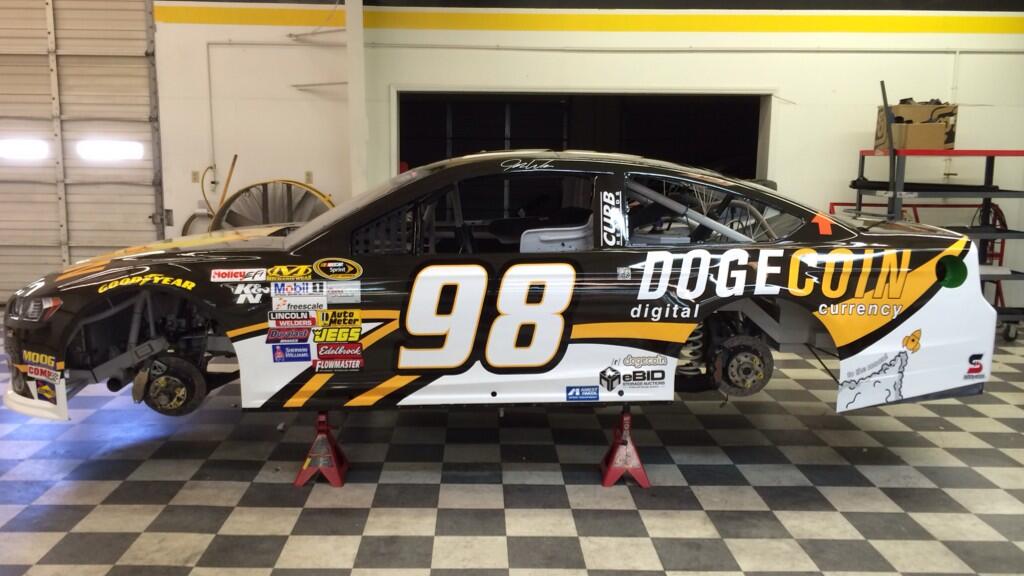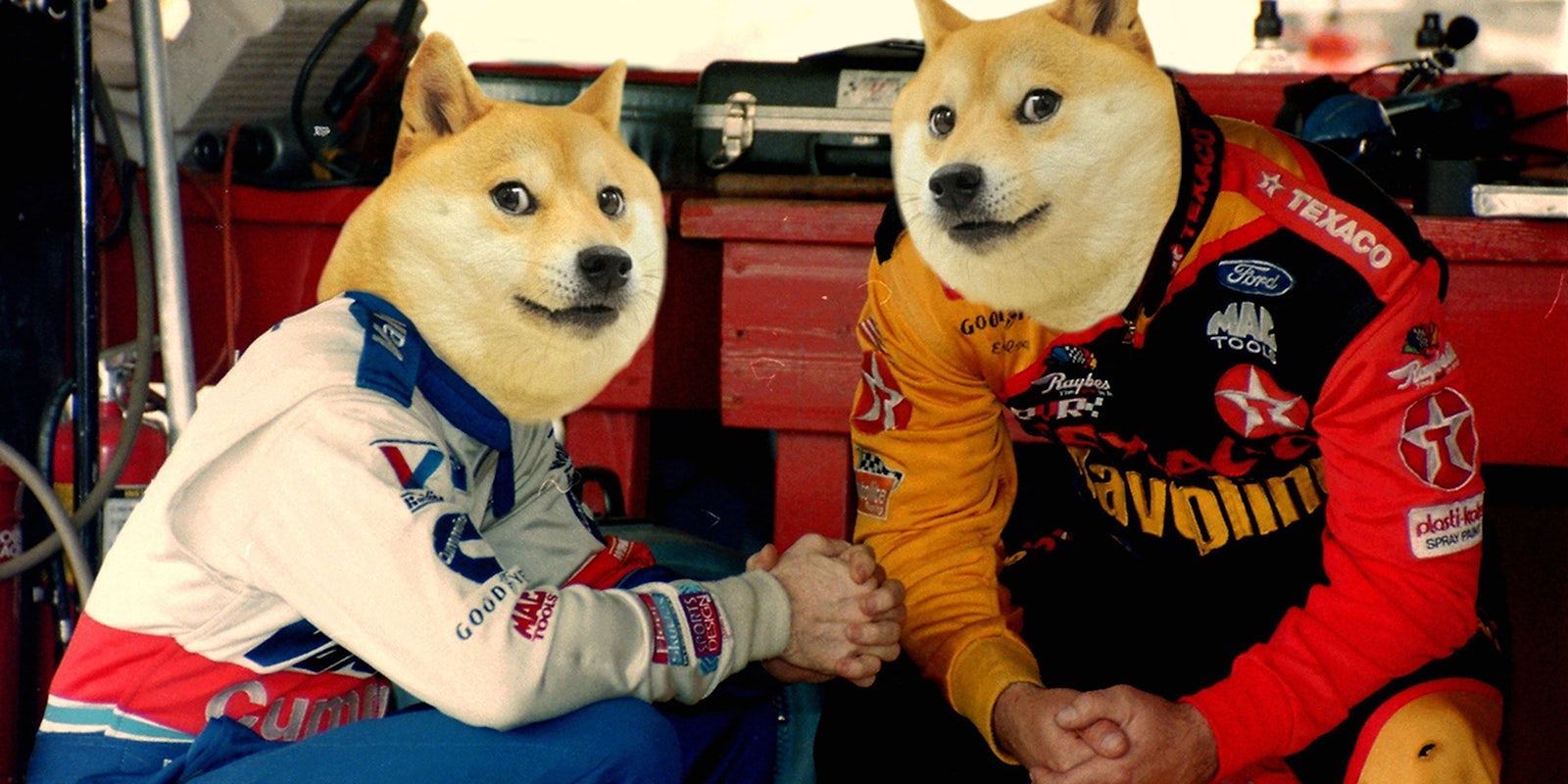Kick the tires and light the fires, big doggy—Doge is headed for the races.
On Sunday, Internet culture will bleed into the lives of unsuspecting Americans as NASCAR driver Josh Wise gets behind the wheel of the Dogecar at the Talladega Superspeedway for the Aaron’s 499 race.
The Dogecar, for the uninitiated, is a souped-up Ford Fusion sponsored entirely by users of the Dogecoin cryptocurrency—electronic money branded by the Doge meme that was originally meant as a joke. But this weekend, Dogecoin users are hoping to laugh all the way across the finish line in first place.
Considering Talladega will likely be most Dogecoin users’ first NASCAR race, here’s a quick primer on what you need to know about the sport besides turn left and drive fast.
1) ‘NASCAR,’ much acronym
That’s right, NASCAR is an acronym, which stands for National Association for Stock Car Auto Racing. Nobody actually calls it that. But hey, knowledge.
2) (Not) so stock
Fun fact: The cars are no longer stock—as in, basically the same as what you’d buy at your local car dealership. Teams engineer custom parts to squeeze out as much performance as possible out of their cars.
Basically, everything that can be measured and controlled, from ride height to horsepower, is measured. And there are strict limitations to the tweaks teams can make to their cars, in an attempt to keep things fair. Engines cannot exceed 358 cubic inches, for example. And all tries used during the race are the same Goodyear rubbers.
In most races, NASCAR cars generate about 850 horsepower. Talladega is one of two tracks (the other being Daytona) where cars must use something called a restrictor plate, which greatly reduces the engines’ pony output by restricting airflow to the engine. This means drivers often bunch up into packs of cars, which can often lead to more crashes. It also means that underdogs like Wise have a chance at further NASCAR glory.

Photo via Imgur
3) Such point system
A point system? Yes, a point system. It goes from 1 point to 48 points in a single race, like Talladega. The driver that comes in 43rd (last) place gets one point, 2nd place gets 42 points, and 1st place earns 43 points plus an addition three bonus points, for a total of 46 points to the winner.
A bonus point is awarded to each driver who leads a lap. The driver who leads the most laps also earns an extra point. The most points any driver can earn in a single race—by leading the most laps and winning the race—is 48.
4) Very qualify
Any driver who wins a race and ranks in the top 30 point holders during the regular 26-race NASCAR season automatically lands one of the 16 spots in the Chase for the Sprint Cup, which is like the postseason of NASCAR. (The driver with the most points, but no win, qualifies for the 16th spot.) This means a win at Talladega would be huge for Wise. But first, he has to qualify during Saturday’s qualifying rounds. Otherwise, he won’t be going anywhere close to the moon.
Update: Wise qualified! He’ll be starting in 37th place, row 19. Even NASCAR is excited:
Nicely done, @dogecoin. cc: @Josh_Wise @reddit #NASCAR #MuchDraft #VeryDega pic.twitter.com/rna3Z5Jm4d
— NASCAR (@NASCAR) May 2, 2014
Despite this victory, Wise is still a bit bummed that he didn’t do better.
Dang. Wanted to qualify better than that. This group qualifying is not easy when your a single car team.
— Josh Wise (@Josh_Wise) May 3, 2014
5) Wow, flags
NASCAR races involve a bunch of flags, each with its own meaning. They are as follows:
-
Green: Race begins, or resumes after a “conditional” flag is waved
-
Yellow: Caution—there’s something on the track causing a hazard. All cars must line up and drive behind the pace car (the lone car at the front) until the hazard is cleared.
-
Red: All racing comes to a stop, and pit crews have to stop working. Drivers are required to pull over into a designated area until racing resumes. You’ll see this if there’s a serious wreck or it starts to rain, which might happen.
-
Black: Waved for a single driver, who must pull into the pit due to breaking a rule (like going too fast in the pit lane or not going fast enough on the track), or for some safety reason (like dropping debris on the track).
-
Black with white stripe: Meant for a driver who fails to pit after the black flag is waved. This driver can’t earn lap points until further notice.
-
Blue with yellow stripe: Waved as a courtesy for slower drivers who are about to be passed by cars in the lead.
-
White: Waved when the lead car begins the last lap.
-
Checkered: You know what this flag means.
6) Very cursed
The Talladega Superspeedway is a so-called tri-oval track (kind of a oddly shaped oval) that measures 2.66 miles long. The track is the widest and longest oval track in NASCAR, and is known for being particularly treacherous due to its ultra-smooth surface. Oh, and some people think the track is cursed.
7) Much speed
Despite those restrictor plates, speeds at Talladega often exceed 200 mph. This is a good thing, as the race is 500 miles long.
8) So longshot
As excited as Dogecoin users must be to see their beloved Wise drive the Dogecar in first place, such an outcome is a longshot. Wise is currently ranked 36th overall. But that doesn’t mean he won’t try to make his fellow shibes proud.
“That would just be surreal to have (a win) happen, but there’s no doubt it’s a possibility,” Wise told USA Today on Wednesday. “I dream about it every day. I was dreaming about it today for an hour while I was riding my bike.”
To the moon!
Correction: The Aaron’s 499 is 500 miles long, not 500 laps.
Thanks to Will Goshen for explaining NASCAR to this noob.
Photo via Darryl W. Moran Photography/Flickr (CC BY-SA 2.0) | Remix by Jason Reed


